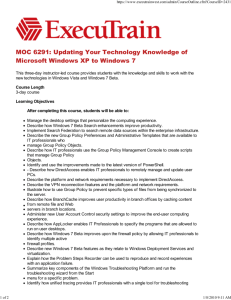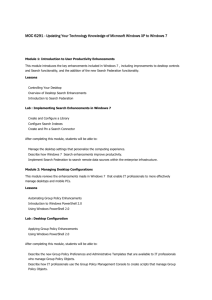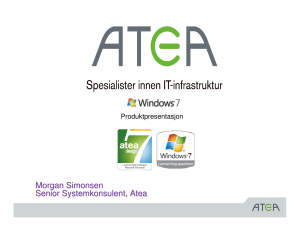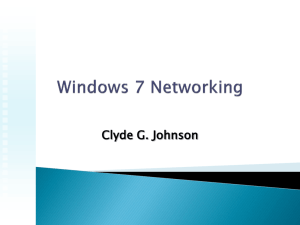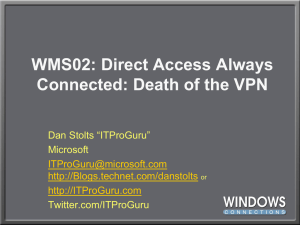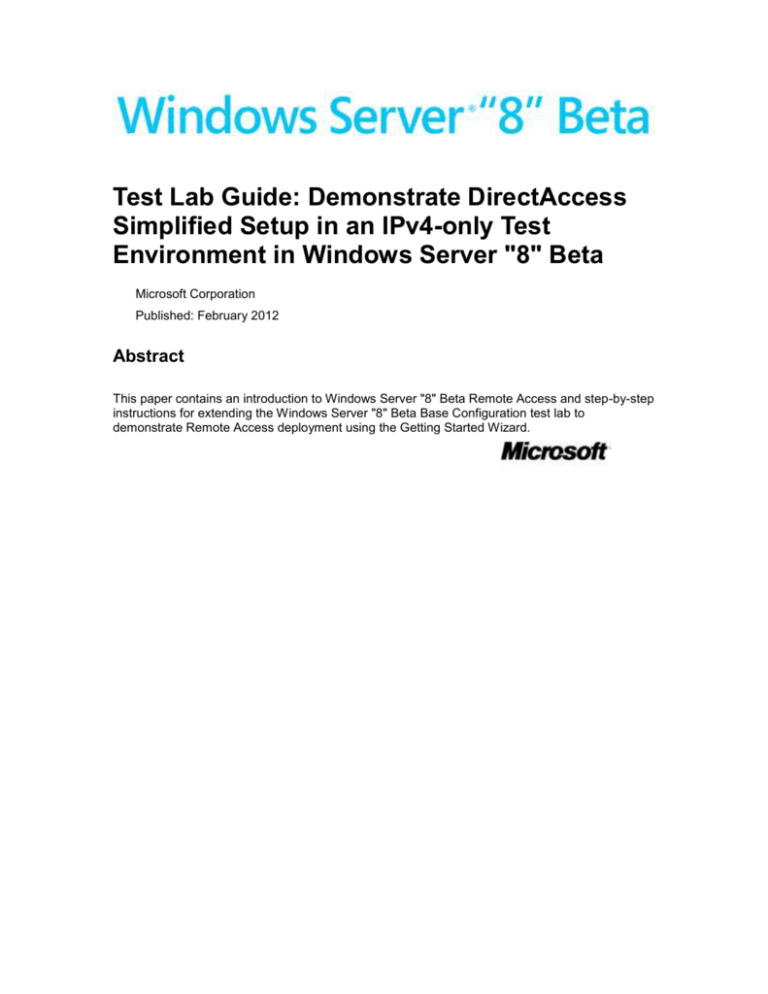
Test Lab Guide: Demonstrate DirectAccess
Simplified Setup in an IPv4-only Test
Environment in Windows Server "8" Beta
Microsoft Corporation
Published: February 2012
Abstract
This paper contains an introduction to Windows Server "8" Beta Remote Access and step-by-step
instructions for extending the Windows Server "8" Beta Base Configuration test lab to
demonstrate Remote Access deployment using the Getting Started Wizard.
Copyright information
This document is provided “as-is”. Information and views expressed in this document, including URL and
other Internet Web site references, may change without notice.
Some examples depicted herein are provided for illustration only and are fictitious. No real association or
connection is intended or should be inferred.
This document does not provide you with any legal rights to any intellectual property in any Microsoft
product. You may copy and use this document for your internal, reference purposes.
© 2012 Microsoft. All rights reserved.
Active Directory, Hyper-V, Microsoft, MS-DOS, Visual Basic, Visual Studio, Windows, Windows NT,
Windows Server, and Windows Vista are trademarks of the Microsoft group of companies.
All other trademarks are property of their respective owners.
Contents
Introduction ..................................................................................................................................... 5
In this guide .................................................................................................................................. 5
Test lab overview ......................................................................................................................... 6
Hardware and software requirements ........................................................................................ 7
Steps for Configuring the Remote Access Test Lab ......................................................................... 8
Step 1: Set up the Base Configuration Test Lab ........................................................................... 9
Step 2: Configure DC1 .................................................................................................................. 9
Create a security group for DirectAccess client computers ..................................................... 9
Step 3: Configure EDGE1 ............................................................................................................ 10
Install the Remote Access server role on EDGE1.................................................................... 10
Deploy simplified DirectAccess using the Getting Started Wizard ......................................... 11
Step 4: Configure CLIENT1 ......................................................................................................... 12
Connect CLIENT1 to the Corpnet subnet and update group policy........................................ 12
Connect CLIENT1 to the Internet subnet and test remote access ......................................... 13
Connect CLIENT1 to the Homenet subnet and test remote access ....................................... 14
Monitor the client connection on the EDGE1 DirectAccess server ........................................ 15
Snapshot the Configuration........................................................................................................... 16
Additional Resources ..................................................................................................................... 16
Introduction
DirectAccess provides users with the experience of being seamlessly connected to their intranet
any time they have Internet access. When DirectAccess is enabled, requests for intranet
resources (such as email servers, shared folders, or intranet websites) are securely directed to
the intranet, without the need for users to connect to a VPN. DirectAccess enables increased
productivity for a mobile workforce by offering the same connectivity experience both inside
and outside of the office.
The Windows Routing and Remote Access Server (RRAS) provides traditional VPN connectivity
for legacy clients and non-domain members. RRAS also provides site-to-site connections
between servers. RRAS in Windows Server 2008 Beta R2 cannot coexist on the same edge server
with DirectAccess, and must be deployed and managed separately from DirectAccess.
Windows Server "8" Beta combines the DirectAccess feature and the RRAS role service into a
new unified server role. This new Remote Access server role allows for centralized
administration, configuration, and monitoring of both DirectAccess and VPN-based remote
access services. Additionally, Windows Server "8" Beta DirectAccess provides multiple updates
and improvements to address deployment blockers and provide simplified management.
Administrators can now deploy DirectAccess using a new Getting Started Wizard, which presents
a greatly simplified configuration experience. The Getting Started Wizard masks the complexity
of DirectAccess, and allows for an automated setup in a few simple steps. The administrator no
longer requires an understanding of the technical details of things like IPv6 transition
technologies and Network Location Server (NLS) deployment.
The new setup wizard provides a seamless experience for the administrator by configuring
Kerberos proxy automatically to eliminate the need for an internal PKI deployment. In this
simplified DirectAccess deployment, user level configuration options such as force tunneling,
Network Access Protection (NAP) integration, and two-factor authentication are not available.
However, it is possible to modify the simplified deployment later by running the Remote Access
Setup Wizard, which provides support for all DirectAccess deployment options.
In this guide
This guide provides step-by-step instructions for configuring DirectAccess using the Getting
Started Wizard in a test lab to demonstrate functionality of the simplified deployment
experience. You will set up and deploy DirectAccess based on the Windows Server "8" Beta Base
Configuration using five server computers and two client computers. The resulting test lab
simulates an intranet, the Internet, and a home network, and demonstrates DirectAccess in
different Internet connection scenarios.
Important
The following instructions are for configuring a Remote Access test lab using the
minimum number of computers. Individual computers are needed to separate the
5
services provided on the network and to clearly show the desired functionality. This
configuration is neither designed to reflect best practices nor does it reflect a desired or
recommended configuration for a production network. The configuration, including IP
addresses and all other configuration parameters, is designed only to work on a
separate test lab network.
Attempting to adapt this Remote Access test lab configuration to a pilot or production
deployment can result in configuration or functionality issues.
Test lab overview
In this test lab, Remote Access is deployed with:
One computer running Windows Server "8" Beta named DC1 that is configured as an
intranet domain controller, Domain Name System (DNS) server, and Dynamic Host
Configuration Protocol (DHCP) server
One intranet member server running Windows Server "8" Beta named EDGE1 that is
configured as a DirectAccess server
One intranet member server running Windows Server "8" Beta named APP1 that is
configured as a general application server and web server
One standalone server running Windows Server "8" Beta named INET1 that is configured as
an Internet DHCP server, DNS server, and web server
One roaming member client computer running Windows 8 Consumer Preview named
CLIENT1 that is configured as a DirectAccess client
One standalone client computer running Windows 8 Consumer Preview named NAT1 that is
configured as a network address translation (NAT) device using Internet Connection Sharing
The Remote Access test lab consists of three subnets that simulate the following:
The Internet (131.107.0.0/24).
An intranet named Corpnet (10.0.0.0/24) separated from the Internet by EDGE1.
A home network named Homenet (192.168.137.0/24) connected to the Internet subnet by a
NAT
Computers on each subnet connect using a hub or switch. See the following figure.
6
Figure 1 DirectAccess Getting Started wizard IPv4-only lab configuration
Windows Server "8" Beta DirectAccess does not require IPv6 deployment or a PKI infrastructure
to deploy a simplified remote access solution. This modular test lab demonstrates DirectAccess
in an IPv4-only environment with no existing certificates. A test client computer is used to show
connectivity to corporate resources via a simulated corporate network (the Corpnet subnet),
simulated Internet (the Internet subnet), and a simulated home network behind a NAT (the
Homenet subnet).
Hardware and software requirements
The following are required components of the test lab:
The product disc or files for Windows Server "8" Beta
The product disc or files for Windows 8 Consumer Preview
Five computers or virtual machines that meet the minimum hardware requirements for
Windows Server "8" Beta
7
Steps for Configuring the Remote Access Test Lab
There are four steps to follow when setting up a Remote Access express setup test lab based on
the Test Lab Guide Base Configuration.
1. Set up the Base Configuration test lab.
The Remote Access simplified setup test lab requires the Test Lab Guide: Windows
Server "8" Beta Base Configuration with Optional mini-module: Homenet subnet, as its
starting point.
2. Configure DC1.
DC1 is already configured as a domain controller with Active Directory, and as the DNS
and DHCP server for the intranet subnet. For the DirectAccess simplified setup test lab, a
security group will be added to Active Directory for DirectAccess client computers.
3. Configure EDGE1.
EDGE1 is already a member server computer. For the Remote Access express setup test
lab, EDGE1 must be configured as a Remote Access server with simplified DirectAccess
deployed.
4. Configure CLIENT1.
CLIENT1 is already a domain member client computer running Windows 8 Consumer
Preview. For the Remote Access express setup test lab, CLIENT1 will be used to test and
demonstrate remote access operation.
Note
You must be logged on as a member of the Domain Admins group or a member of the
Administrators group on each computer to complete the tasks described in this guide. If
you cannot complete a task while you are logged on with an account that is a member
of the Administrators group, try performing the task while you are logged on with an
account that is a member of the Domain Admins group.
This guide provides steps for configuring the computers of the Windows Server "8" Beta Base
Configuration test lab, configuring Remote Access in Windows Server "8" Beta, and
demonstrating remote client connectivity. The following sections provide details about how to
perform these tasks.
8
Step 1: Set up the Base Configuration Test Lab
Set up the Base Configuration test lab for both the Corpnet and Internet subnets using the
procedures in the “Steps for Configuring the Corpnet Subnet” and “Steps for Configuring the
Internet Subnet” sections of the Test Lab Guide: Windows Server "8" Beta Base Configuration.
Set up the Homenet subnet using the procedures in the Optional mini-module: Homenet
subnet.
Do NOT complete the procedures in the Optional mini-module: Basic PKI. This Remote Access
test lab demonstrates the ability to deploy DirectAccess in an environment without a PKI
deployment.
Step 2: Configure DC1
DC1 configuration for the Remote Access express setup test lab consists of the following
procedure:
Create a security group for DirectAccess client computers
The following section explains this procedure in detail.
Create a security group for DirectAccess client computers
When DirectAccess is configured, it automatically creates group policy objects containing
DirectAccess settings, and these are applied to DirectAccess clients and servers. By default, the
Getting Started Wizard applies the client GPO to mobile computers only, in the Domain
Computers security group. The procedures in this lab do not use the default setting, but instead
create an alternate security group for DirectAccess clients.
To create a DirectAccess client security group
1. On DC1, from the Start screen, click Active Directory Administrative Center.
2. In the console tree, click the arrow to expand corp (local), and then click Users.
3. In the Tasks pane, click New, and then click Group.
4. In the Create Group dialog, type DirectAccessClients for Group name.
5. Scroll down to access the Members section of the Create Group dialog, and click Add.
6. Click Object Types, select Computers, and click OK.
7. Type CLIENT1, and then click OK.
8. Click OK to close the Create Group dialog.
9. Exit the Active Directory Administrative Center.
9
Windows PowerShell equivalent commands
The following Windows PowerShell cmdlet or cmdlets perform the same function as the preceding
procedure. Enter each cmdlet on a single line, even though they may appear word-wrapped across
several lines here because of formatting constraints.
New-ADGroup -GroupScope global -Name DirectAccessClients
Add-ADGroupMember -Identity DirectAccessClients -Members CLIENT1$
Step 3: Configure EDGE1
EDGE1 configuration for the DirectAccess simplified deployment in an IPv4-only environment
test lab consists of the following procedures:
Install the Remote Access server role on EDGE1
Deploy simplified DirectAccess using the Getting Started Wizard
The following sections explain these procedures in detail.
Install the Remote Access server role on EDGE1
The Remote Access server role in Windows Server "8" Beta combines the DirectAccess feature
and the RRAS role service into a new unified server role. This new Remote Access server role
allows for centralized administration, configuration, and monitoring of both DirectAccess and
VPN-based remote access services. Use the following procedure to install the Remote Access
role on EDGE1.
To install the Remote Access server role on EDGE1
1. In the Dashboard console of Server Manager, under Configure this local server, click
Add roles and features.
2. Click Next three times to get to the server role selection screen.
3. In the Select Server Roles dialog, select Remote Access, click Add Features when
prompted, and then click Next.
4. Click Next five times to accept the defaults for features, remote access role services, and
web server role services.
5. On the Confirmation screen, click Install.
6. Wait for the feature installations to complete, and then click Close.
10
Windows PowerShell equivalent commands
The following Windows PowerShell cmdlet or cmdlets perform the same function as the preceding
procedure. Enter each cmdlet on a single line, even though they may appear word-wrapped across
several lines here because of formatting constraints.
Install-WindowsFeature RemoteAccess -IncludeManagementTools
Deploy simplified DirectAccess using the Getting Started Wizard
The new Getting Started Wizard presents a greatly simplified configuration experience. The
wizard masks the complexity of DirectAccess, and allows for an automated setup in a few simple
steps. The wizard provides a seamless experience for the administrator by configuring Kerberos
proxy automatically to eliminate the need for an internal PKI deployment. Use the following
procedure to deploy simplified DirectAccess on EDGE1.
To configure DirectAccess using the Getting Started Wizard on EDGE1
1. From the Start screen, click Remote Access Management.
2. In the Remote Access Management console, click Run the Getting Started Wizard.
3. Click Deploy DirectAccess only.
4. Verify that Edge is selected as the network topology. Type edge1.contoso.com as the
public name to which remote access clients will connect. Click Next.
Note: By default, the Getting Started Wizard deploys DirectAccess to all laptops and
notebook computers in the domain by applying a WMI filter to the client settings GPO.
This default is not appropriate for the lab environment. Since the CLIENT1 PC is a
member of the DirectAccessClients security group in Active Directory, take the following
steps to change the client security group setting for DirectAccess.
5. On the final wizard page, click the link supplied to edit the wizard settings.
6. In the Remote Access Review dialog, next to Remote Clients, click Change.
7. On the Select Groups screen, clear the Enable DirectAccess for mobile computers only
checkbox.
8. Click Domain Computers (CORP\Domain Computers), and then click Remove.
9. Click Add, type DirectAccessClients, and then click OK.
11
10. Click Next, and then click Finish.
11. Click OK in the Remote Access Review screen, and then click Finish.
12. Since there is no PKI deployment in this test lab, the wizard will automatically provision
self-signed certificates for IP-HTTPS and the Network Location Server, and will
automatically enable Kerberos proxy. The wizard will also enable NAT64 and DNS64 for
protocol translation in the IPv4-only environment. After the wizard successfully
completes applying the configuration, click Close.
13. In the console tree of the Remote Access Management console, select Operations
Status. Wait until the status of all monitors display as "Working". From the Tasks pane
under Monitoring, click Refresh periodically to update the display.
Step 4: Configure CLIENT1
Use the following procedures to demonstrate remote access connectivity with CLIENT1:
Connect CLIENT1 to the Corpnet subnet and update group policy
Connect CLIENT1 to the Internet subnet and test remote access
Connect CLIENT1 to the Homenet subnet and test remote access
Monitor the client connection on the EDGE1 DirectAccess server
The following sections explain these procedures in detail.
Connect CLIENT1 to the Corpnet subnet and update group policy
To receive the DirectAccess settings, CLIENT1 must update its group policy while connected to
the Corpnet subnet.
To update group policy on CLIENT1 and apply DirectAccess settings
1. Connect CLIENT1 to the Corpnet subnet. Reboot CLIENT1 while connected to the
Corpnet subnet to update its security group membership and apply the DirectAccess
client group policy settings.
2. From the Start screen, type PowerShell, then right-click Windows PowerShell, and click
Run as administrator.
3. Type Get-DnsClientNrptPolicy and hit ENTER. The Name Resolution Policy Table (NRPT)
entries for DirectAccess are displayed. Note that the NLS server exemption is displayed
as DirectAccess-NLS.corp.contoso.com. The Getting Started wizard automatically
created this DNS entry for the DirectAccess server, and provisioned an associated selfsigned certificate so that the DirectAccess server can function as the Network Location
12
Server.
4. Type Get-NCSIPolicyConfiguration and hit ENTER. The network connectivity status
indicator settings deployed by the wizard are displayed. Note that the value of
DomainLocationDeterminationURL is https://DirectAccessNLS.corp.contoso.com:443/insideoutside. Whenever this network location server URL is
accessible, the client will determine that it is inside the corporate network, and NRPT
settings will not be applied.
5. Type Get-DAConnectionStatus and hit ENTER. Since the client can reach the network
location server URL, the status will display as ConnectedLocally.
Connect CLIENT1 to the Internet subnet and test remote access
To test remote access connectivity from the Internet, move the CLIENT1 connection to the
Internet subnet.
To test remote access from the Internet
1. Connect CLIENT1 to the Internet subnet. Once the network determination process
completes, the network icon should indicate Internet access.
2. In the PowerShell window, type Get-DAConnectionStatus and hit ENTER. The status
should show as ConnectedRemotely.
3. Click the network icon in the System Notification Area. Note that Workplace Connection
is listed as Connected. This is the default connection name provided by the DirectAccess
wizard.
4. Right-click Workplace Connection and then click Properties. Note that Status shows as
Connected.
5. From the PowerShell prompt, type ping inet1.isp.example.com and hit ENTER to verify
Internet name resolution and connectivity. You should receive four replies from
131.107.0.1.
6. Type ping app1.corp.contoso.com and hit ENTER to verify corporate intranet name
resolution and connectivity. Note the format of the IPv6 address returned. Since there is
no IPv6 deployed in the test lab, the dynamically created NAT64 address of APP1 is
returned. The dynamically created prefix assigned by DirectAccess for NAT64 will be in
the form fdxx:xxxx:xxxx:7777::/96.
7. Click the Internet Explorer icon to launch IE. Verify that you can access the websites on
http://inet1.isp.example.com and http://app1.corp.contoso.com.
13
8. From the desktop taskbar, click the Windows Explorer icon.
9. In the address bar, type \\app1\Files, and then press ENTER.
10. You should see a folder window with the contents of the Files shared folder.
11. In the Files shared folder window, double-click the Example.txt file. You should see the
contents of the Example.txt file.
12. Close the example.txt - Notepad and the Files shared folder windows.
13. From the PowerShell window, type Get-NetIPAddress and then press ENTER to examine
the client's IPv6 configuration. Note that the tunnel adapter iphttpsinterface is active
with a valid IP-HTTPS address. CLIENT1 is using IP-HTTPS to tunnel IPv6 traffic to the
EDGE1 server.
14. Type Get-NetIPHTTPSConfiguration and hit ENTER. Examine the settings applied by
group policy to direct the client to https://edge1.contoso.com:443/IPHTTPS.
15. Type wf.msc and then hit ENTER to launch the Windows Firewall with Advanced Security
console. Expand Monitoring, then Security Associations to examine the IPsec SAs
established. Note that the authentication methods used are Computer Kerberos and User
Kerberos, and that no certificate-based authentication was needed to establish the single
tunnel simplified connection security rule. The client leverages the Kerberos proxy
automatically deployed by the DirectAccess wizard. Select Connection Security Rules in
the console tree to examine the associated policies applied.
16. Close the Windows Firewall with Advanced Security console.
Connect CLIENT1 to the Homenet subnet and test remote access
To test remote access connectivity from a simulated home network behind a NAT, move the
CLIENT1 connection to the Homenet subnet.
To test remote access from the home network
1. Connect CLIENT1 to the Homenet subnet. Once the network determination process
completes, the network icon should indicate Internet access.
2. In the PowerShell window, type Get-DAConnectionStatus and hit ENTER. The status
should show as ConnectedRemotely.
3. Click the network icon in the System Notification Area. Note that Workplace Connection
is listed as Connected. Right-click Workplace Connection and then click Properties. Note
that Status shows as Connected.
4. Type ping app1.corp.contoso.com and hit ENTER to verify corporate intranet name
14
resolution and connectivity. Again, since there is no IPv6 deployed in the test lab, the
dynamically created NAT64 address of APP1 is returned.
5. Click the Internet Explorer icon to launch IE. Verify that you can access the websites on
http://inet1.isp.example.com and http://app1.corp.contoso.com.
6. Click Start, and then click the Windows Explorer icon.
7. In the address bar, type \\app1\Files, and then press ENTER.
8. You should see a folder window with the contents of the Files shared folder.
9. In the Files shared folder window, double-click the Example.txt file. You should see the
contents of the Example.txt file.
10. Close the example.txt - Notepad and the Files shared folder windows.
11. From the PowerShell window, type Get-NetIPAddress and then press ENTER to examine
the client's IPv6 configuration. Note that the tunnel adapter iphttpsinterface is active
with a valid IP-HTTPS address. CLIENT1 is using IP-HTTPS to tunnel IPv6 traffic to the
EDGE1 server. In previous versions of DirectAccess, a client with a private IPv4 address
behind a NAT would connect using a Teredo IPv6 transition address. The simplified
DirectAccess deployment wizard configures IP-HTTPS only.
Monitor the client connection on the EDGE1 DirectAccess server
The Remote Access Management Console in Windows Server "8" Beta provides remote client
status monitoring functionality for both DirectAccess and VPN connections.
To monitor the client connection on EGDE1
1. From the Start screen, click Remote Access Management.
2. In the Remote Access Management console, select Dashboard.
3. Examine the data collected under Remote Client Status.
4. In the Remote Access Management console, select Remote Client Status.
5. Double-click the CLIENT1 connection to display the detailed remote client statistics
dialog.
15
Snapshot the Configuration
This completes the DirectAccess simplified deployment in an IPv4-only environment test lab. To
save this configuration so that you can quickly return to a working Remote Access configuration
from which you can test other Remote Access modular test lab guides (TLGs), TLG extensions, or
for your own experimentation and learning, do the following:
1. On all physical computers or virtual machines in the test lab, close all windows and then
perform a graceful shutdown.
2. If your lab is based on virtual machines, save a snapshot of each virtual machine and name
the snapshots DirectAccess simplified IPv4-only. If your lab uses physical computers, create
disk images to save the DirectAccess simplified IPv4-only test lab configuration.
Additional Resources
For more information about DirectAccess, see the DirectAccess TechNet portal page.
For a list of all of the Windows Server "8" Beta TLGs, see Windows Server "8" Beta Test Lab
Guides in the TechNet Wiki.
For a list of additional Microsoft TLGs, see Test Lab Guides in the TechNet Wiki.
To provide the authors of this guide with feedback or suggestions for improvement, send an
email message to tlgfb@microsoft.com.
16

